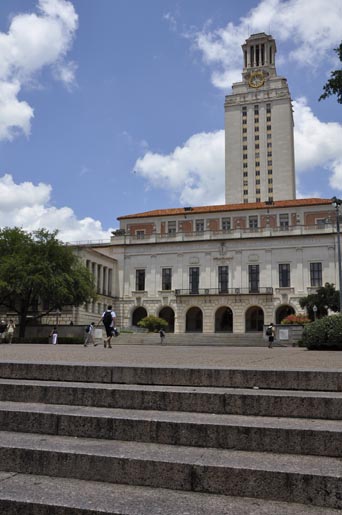Mythbusting Mr. O, Part 1
Last Wednesday, the Texas Tribune interviewed Rick O’Donnell, the controversial, short-term employee the UT System regents hired, fired, and last week paid $70,000 to avoid a lawsuit. While I believe Mr. O’Donnell sincerely believes what he says, I also believe he is biased and, consequently, wrong on a number of fronts.
Editor’s Note: This is the first of two posts on this issue. Read part two.

File photo by Val Cook
It really is about research. Mr. O’Donnell suggests that the controversy at hand is not about research and that UT-Austin advocates raise that issue as a red herring. The sense of research being under attack is real. He can diminish the significance of his flawed white paper on research or implementing budgets that separate research from teaching, but this is the core of what makes UT-Austin exceptional and was the foundation for the burnt-orange call to arms.
It really isn’t about the regents, but process. The Texas Exes’ alarm over the issues of Mr. O’Donnell’s hiring and the unproven policy initiatives he is associated with came about because of a flawed, non-inclusive, and alarming hiring process, as well as his writings and associations.
UT System Board of Regents Chair Gene Powell hired Rick O’Donnell without the participation of other regents or the chancellor. O’Donnell became the 18th-highest-paid employee during a system-wide hiring freeze in the face of massive budget cuts and the largest budget shortfall in Texas history.
He asked people not to judge him based on things he had written or individuals and institutions of his past. Yet his actions appeared to align with those very writings and associations.
No one is alarmed that regents would serve their role as regents. The concern was the unprecedented break from steady oversight stewardship to micromanagement. I know of no time in the history of the UT System that any employee apart from the chancellor reported directly to the regents.
A few years ago, the UT Board of Regents demonstrated the type of thoughtful process we expect when it reviewed the Brackenridge Tract property in West Austin. The thorough, transparent process included multiple stakeholder groups over an extended period, assisted by a professional firm. When the regents deviate from this precedent of transparent data collection and discernment, it causes understandable alarm.
I don’t think this process was malevolent on Chairman Powell’s part. What probably works well in private real estate would not successfully build trust, generate consensus, and foster stakeholder buy-in for dynamic, complex university systems. Just as many of us find fault with his process, Chairman Powell expressed concerns about the Texas Exes’ decision to share our concerns in an open letter. Both sides clearly perceive communication and process deficits from the other.
This was not an overreaction. The role of regent is like that of a Federal Reserve board member: Their words will be parsed and their actions must be steady for risk of destabilizing complex markets and overall public confidence. This process and the associated “breakthrough solutions” threaten the university’s standing and prestige.
Here’s why: There are only two major market forces in higher education: the labor force (faculty) and the learning force (students). Faculty choose where to teach, and a great faculty member can choose anywhere. Great students are recruited and choose the institution that they believe is the best match. One of the most important factors for both groups is prestige.
The pushback from the UT community was in large part because of what we witnessed at Texas A&M. There are lessons to be mined from A&M’s “red and black” reports, including lower morale (which can only negatively impact productivity and faculty recruitment) and deflated national reputation. A&M experienced its first peer-rating decrease in a decade in the first survey after the national publicity from the think tank “reforms.”
Unvetted policies that potentially damage our most elusive capital—our reputation— interfere with our ability to attract the best and the brightest.
Our colors are orange and white. Mr. O’Donnell, in an attempt to illustrate the political dynamics of his situation, suggested that Senator Judith Zaffirini “bleeds orange and purple.” The only school I know of that employs that combination is Clemson University. While I am sure it is a simple mistake, I think it symbolizes his engagement with the UT-System: It was not a match.
Read part two here.
JJ Baskin is member of the Texas Exes Public Affairs Committee and the Coalition for Excellence in Higher Education.

















11 Comments